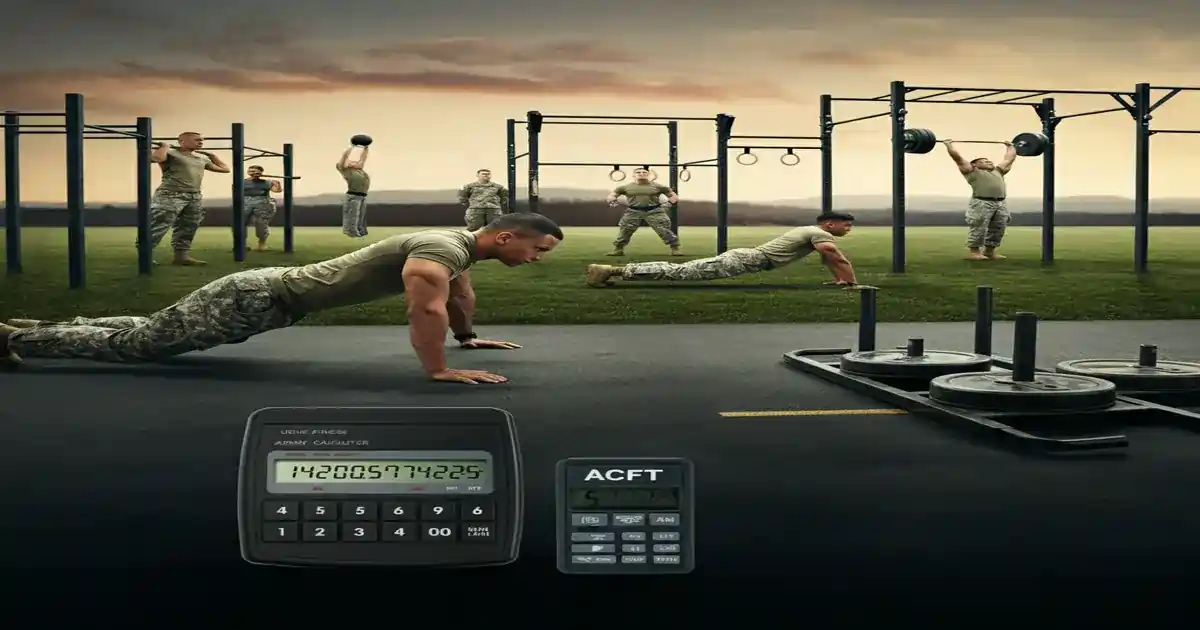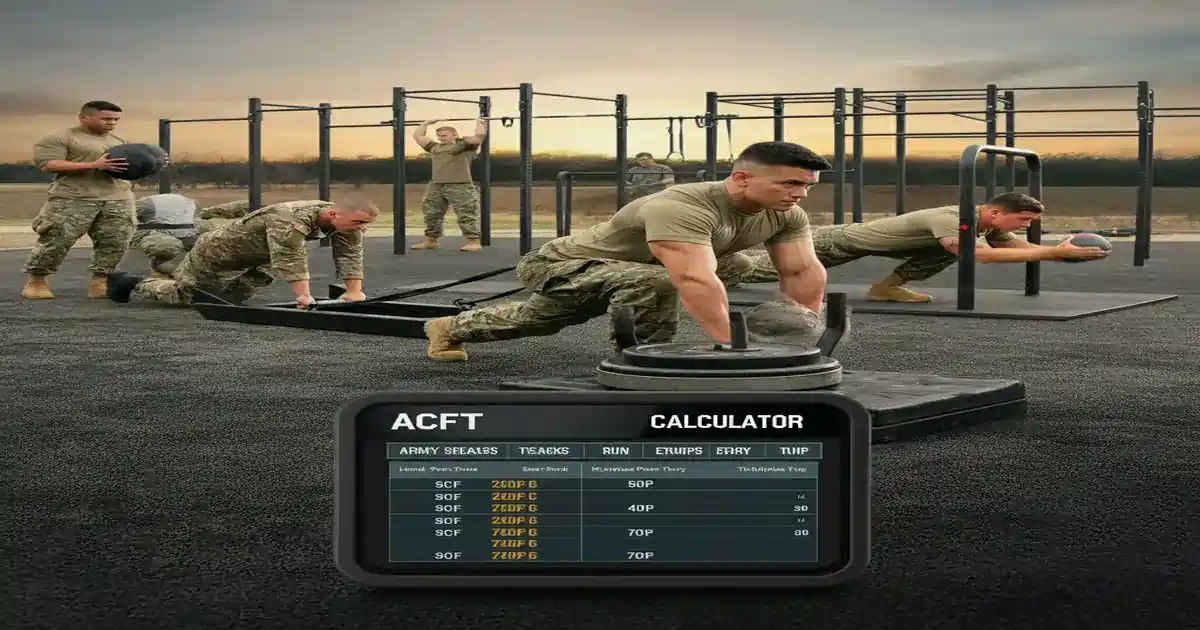1. Introduction
The Army Combat Fitness Test (ACFT) is a pivotal element in the U.S. Army’s efforts to ensure soldiers are physically prepared for combat. The ACFT not only assesses a soldier’s physical strength, endurance, and agility but also directly impacts their career progression. This article will guide you through the components of the ACFT, the importance of using an ACFT calculator, and provide tips on how to effectively train and improve your score.
ACFT Calculator
2. What is the ACFT?
a. Definition and Purpose
The ACFT is a comprehensive fitness test designed to evaluate a soldier’s physical readiness for combat. Unlike its predecessor, the Army Physical Fitness Test (APFT), the ACFT offers a more holistic approach by testing various aspects of physical fitness, such as strength, endurance, power, and speed.

b. Historical Context of ACFT Development
The ACFT was introduced to address the gaps in the APFT, which primarily focused on aerobic and muscular endurance. The ACFT better reflects the physical demands soldiers face in modern combat scenarios, thereby enhancing overall combat readiness.
3. Importance of the ACFT in the Military
a. Ensuring Combat Readiness
The ACFT is more than just a fitness test; it’s a measure of a soldier’s ability to perform under stress in real-world situations. Soldiers who excel in the ACFT are more likely to be effective in combat, contributing to the overall effectiveness of their unit.
b. Impact on Career Progression
Performance in the ACFT can influence a soldier’s promotions, special assignments, and opportunities for advancement. A higher score can provide an edge in highly competitive military career paths.

4. Overview of the ACFT Calculator
a. Purpose and Benefits
The ACFT Calculator is a valuable tool for soldiers and trainers, offering a way to input results from each event and calculate an overall score. This helps in identifying strengths and weaknesses, allowing for targeted training improvements.
b. How It Works
The calculator takes into account age, gender, and performance in each event to provide an accurate score. It adjusts the criteria based on the input data, making it a reliable resource for preparing for the ACFT.
5. The Six Events of the ACFT
a. Three-Repetition Maximum Deadlift (MDL)
The MDL tests lower body and core strength. It requires soldiers to lift a weight three times, emphasizing proper form and strength.
b. Standing Power Throw (SPT)
This event measures explosive power by having soldiers throw a 10-pound medicine ball backward over their heads. It assesses upper body and core strength as well as coordination.
c. Hand-Release Push-Up (HRP)
The HRP evaluates upper body strength and endurance. Soldiers must perform push-ups with a hand release at the bottom position, focusing on maintaining proper form.
d. Sprint-Drag-Carry (SDC)
The SDC assesses anaerobic endurance, speed, and muscular strength. This event involves sprinting, dragging weights, and carrying kettlebells in a timed circuit.
e. Leg Tuck (LTK)
The LTK focuses on upper body and core strength. Soldiers must pull themselves up on a bar until their legs are tucked close to their chest.
f. Two-Mile Run (2MR)
The final event tests aerobic endurance. Soldiers must complete a two-mile run as quickly as possible, demonstrating cardiovascular fitness and stamina.
6. Scoring System for the ACFT
a. Point Scale and Minimum Passing Scores
Each event in the ACFT is scored on a scale from 0 to 100 points, with a maximum total score of 600 points. The minimum passing score is 60 points per event.
b. Age and Gender-Based Criteria
Scores are adjusted based on age and gender to ensure fairness. The ACFT Calculator uses these criteria to provide a personalized score for each soldier.
7. Why Accurate Scoring Matters
a. Fairness and Readiness Assessment
Accurate scoring ensures that all soldiers are assessed fairly, providing a clear picture of their readiness for combat. It also helps pinpoint areas that require improvement.
b. Role in Career Development and Deployment
Scoring well on the ACFT is essential for career progression and deployment readiness. An accurate score is vital for making informed decisions about a soldier’s future roles and responsibilities.
8. How to Use the ACFT Calculator
a. Step-by-Step Guide to Input Data
- Enter your performance results for each of the six events.
- Select your age group and gender.
- The calculator will adjust the criteria based on your inputs and compute your total and individual event scores.
b. Example Calculation Walkthrough
For example, a 25-year-old male soldier who performs well in all events will see how each performance is scored and understand what areas to focus on for improvement.
9. Tips for Using the ACFT Calculator Effectively
a. Regular Practice and Progress Tracking
Regularly using the calculator to track progress can help in identifying trends and areas needing improvement.
b. Focusing on Weak Areas for Improvement
Targeting weaker areas with specific training can lead to a better overall score.
10. Nutrition and Recovery for Optimal Performance
a. Importance of Balanced Diet
A balanced diet with the right mix of proteins, carbs, and fats is essential for energy and recovery.
b. Role of Recovery in Fitness Improvement
Adequate rest and recovery prevent injuries and enhance performance.
11. Common Mistakes to Avoid
a. Ignoring Weak Areas
Neglecting weaker areas can hinder overall performance. It’s crucial to focus on all six events equally.
b. Overtraining and Lack of Recovery
Overtraining can lead to burnout and injuries. Proper rest is vital.
12. Expert Insights on ACFT Preparation
a. Insights from Fitness Experts
Experts recommend a well-rounded fitness program that incorporates strength, agility, and endurance training.
b. Case Studies from Successful Soldiers
Soldiers who have excelled in the ACFT share their training routines and tips for success.
13. Future Outlook of the ACFT
a. Potential Changes and Improvements
The ACFT may evolve as new training methodologies and technologies are developed.
b. Evolution of Training Strategies
As understanding of physical fitness grows, training strategies will continue to evolve to better prepare soldiers for combat.
14. Conclusion
a. Summary of Key Points
The ACFT is a comprehensive test that assesses various aspects of a soldier’s physical capabilities. The ACFT Calculator is a valuable tool for optimizing performance and career progression.
b. Encouragement to Utilize the ACFT Calculator
Regular use of the ACFT Calculator can guide soldiers in achieving their fitness goals and meeting the Army’s rigorous standards.
Master Each Challenge: A Guide to the ACFT Events and Scoring System
The Army Combat Fitness Test (ACFT) represents a transformative approach to evaluating a soldier’s physical preparedness. Designed to ensure soldiers are combat-ready and physically resilient, the ACFT includes six events, each tailored to test various physical attributes essential for military roles. Updated in April 2023, the ACFT categorizes soldiers by Military Occupational Specialty (MOS) into three physical demand categories: Heavy (Black), Significant (Gray), and Moderate (Gold). Let’s break down each event, scoring requirements, and insights to help soldiers master every challenge of the ACFT.
ACFT Overview and Purpose
The ACFT is more than just a fitness test; it reflects the rigorous physical requirements of military service. The test challenges core aspects of fitness such as muscular strength, endurance, agility, and aerobic capacity. These elements are crucial for soldiers, ensuring they can perform high-stress tasks while minimizing the risk of injuries.
The ACFT’s scoring system and requirements are designed to prepare soldiers for real-life combat scenarios and the physical demands associated with various MOS roles. Let’s dive into each event and examine the scoring system, ensuring a comprehensive understanding of the ACFT.
ACFT Categories and Scoring Standards
The ACFT introduces tiered standards for different roles, ensuring that soldiers meet the specific physical demands of their MOS category. The categories are:
- Heavy (Black) – Minimum 440 points, 70 points per event.
- Significant (Gray) – Minimum 440 points, 65 points per event.
- Moderate (Gold) – Minimum 360 points, 60 points per event.
To pass the ACFT, soldiers must accumulate a minimum total score based on their MOS category, with each of the six events contributing up to 100 points. Soldiers must score at least the minimum threshold for each event to meet their MOS standards.
1. Maximum Deadlift (MDL)
Purpose of the Maximum Deadlift
The Maximum Deadlift is a key assessment of a soldier’s total muscular strength, emphasizing lower body power, grip endurance, and core stability. This exercise simulates the physical demands of lifting and carrying heavy loads, mirroring scenarios soldiers may face in the field.
Execution and Action
Soldiers perform three repetitions of their maximum weight deadlift. Proper form is crucial, as it maximizes efficiency and prevents injuries to critical areas like the hips, knees, and lower back. This event emphasizes both physical strength and disciplined execution.
Equipment Needed
A 60-pound hex bar and weight plates are used for this exercise, providing a balanced load that challenges the muscles effectively.
2. Standing Power Throw (SPT)
Purpose of the Standing Power Throw
The Standing Power Throw assesses a soldier’s ability to generate explosive power—a crucial skill for dynamic movements and quick reactions on the battlefield. This event focuses on coordination, balance, and flexibility, which are essential for both combat and daily tasks.
Execution and Action
In this event, soldiers perform a backward overhead throw using a 10-pound medicine ball. The goal is to achieve maximum distance, highlighting the strength and coordination of both the upper and lower body.
Equipment Needed
A 10-pound medicine ball is used for this event, allowing soldiers to develop the explosive power needed for rapid response movements in the field.
3. Hand-Release Push-Up (HRP)
Purpose of the Hand-Release Push-Up
This event targets upper body endurance, a vital component of overall strength and stamina. The Hand-Release Push-Up is a key indicator of a soldier’s muscular endurance, focusing on the arms, chest, and core.
Execution and Action
Soldiers are required to perform as many hand-release push-ups as possible within a two-minute period. This exercise requires soldiers to briefly lift their hands off the ground between each push-up, ensuring full range of motion and challenging the endurance of the upper body.
Equipment Needed
No equipment is required, making this a straightforward yet demanding test of strength and endurance.
4. Sprint / Drag / Carry (SDC)
Purpose of the Sprint / Drag / Carry
The Sprint / Drag / Carry is a composite event that assesses multiple fitness areas simultaneously, including strength, endurance, agility, and coordination. This event mimics the tasks soldiers may encounter on the battlefield, such as sprinting, carrying supplies, and maneuvering quickly under pressure.
Execution and Action
Soldiers perform five 50-meter shuttles, each involving different actions like sprinting, dragging a weighted sled, moving laterally, carrying kettlebells, and sprinting again. This comprehensive activity demands physical versatility and stamina.
Equipment Needed
A sled (used for dragging) and kettlebells are necessary for this event, ensuring soldiers can handle both weighted and dynamic movements effectively.
5. Plank (PLK)
Purpose of the Plank
The plank event is designed to test core strength and stability, both of which are essential for maintaining balance and preventing injuries. A strong core supports the entire body, enabling soldiers to perform other physical tasks with greater efficiency and resilience.
Execution and Action
Soldiers maintain a plank stance for as long as possible. This straightforward exercise is challenging yet invaluable, as it reveals a soldier’s core strength and endurance.
Equipment Needed
No equipment is needed for the plank event, making it an accessible yet intense component of the ACFT.
6. Two-Mile Run (2MR)
Purpose of the Two-Mile Run
This final event measures a soldier’s aerobic endurance and ability to sustain physical activity over an extended period. It tests cardiovascular health, endurance, and mental stamina, all of which are essential in high-intensity combat scenarios.
Execution and Action
Soldiers run two miles on a measured course, with the time taken as the key metric for scoring. This event requires endurance and disciplined pacing, challenging soldiers to push their limits while maintaining a steady pace.
Equipment Needed
No specific equipment is required; soldiers complete the run on a generally flat outdoor course.
ACFT Scoring Scales: Interpreting Your Performance
Each of the six ACFT events is scored out of 100 points, with a maximum total score of 600 points. Points are awarded based on performance in each event, and soldiers must meet the minimum score requirements for their MOS category to pass.
- Heavy (Black): 440 points minimum, with at least 70 points per event.
- Significant (Gray): 440 points minimum, with at least 65 points per event.
- Moderate (Gold): 360 points minimum, with at least 60 points per event.
These scales allow for flexibility while ensuring soldiers maintain a high level of physical readiness tailored to their role.
Tips for Training and Improving ACFT Scores
- Develop a Balanced Training Routine: Incorporate strength, agility, and endurance exercises to cover all ACFT components.
- Focus on Weaknesses: Identify weaker areas and dedicate extra training to those events.
- Work on Form and Technique: Proper technique reduces injury risk and enhances performance.
- Gradually Increase Intensity: Avoid burnout by gradually escalating workout intensity.
- Monitor Progress: Track improvements over time to stay motivated and adjust training as needed.
Preparing Mentally for the ACFT
The ACFT not only tests physical strength but also mental resilience. Building mental stamina through focus, visualization, and resilience training can significantly impact performance. Approaching each event with a determined mindset can make a measurable difference.
The ACFT is an integral part of military readiness, designed to ensure soldiers meet the physical demands of their duties. By understanding each event, maintaining rigorous training, and keeping mental focus, soldiers can achieve and exceed their ACFT goals. This fitness test embodies the high standards of military service, fostering a robust foundation of physical capability and resilience.
FAQs about the ACFT and ACFT Calculator
1. What is the ACFT?
The Army Combat Fitness Test (ACFT) is a physical fitness test used by the U.S. Army to evaluate a soldier’s strength, endurance, and agility. It consists of six events designed to measure different aspects of physical fitness needed in combat situations.
2. What are the six events of the ACFT?
The six events of the ACFT are:
- Three-Repetition Maximum Deadlift (MDL)
- Standing Power Throw (SPT)
- Hand-Release Push-Up (HRP)
- Sprint-Drag-Carry (SDC)
- Leg Tuck (LTK)
- Two-Mile Run (2MR)
3. How is the ACFT scored?
Each event in the ACFT is scored on a scale of 0 to 100 points, with a maximum possible score of 600 points. The minimum passing score for each event is 60 points, but certain roles may require higher scores. The score is based on age, gender, and performance standards.
4. What is the purpose of the ACFT Calculator?
The ACFT Calculator helps soldiers and trainers calculate their ACFT scores by inputting results for each event. It provides an overall score, making it easier to assess performance and identify areas for improvement.
5. How do I use the ACFT Calculator?
To use the ACFT Calculator:
- Enter your performance results for each of the six events.
- Select your age group and gender.
- The calculator will adjust the scoring criteria and compute your total and individual event scores.
6. Why is accurate scoring important for the ACFT?
Accurate scoring ensures fairness and provides a reliable assessment of a soldier’s physical readiness. It is crucial for career progression, deployment readiness, and meeting Army standards.
7. How can I improve my ACFT score?
Improving your ACFT score involves targeted training for each event, consistent practice, proper nutrition, and adequate recovery. Focusing on weaker areas and following a structured training plan can significantly enhance performance.
8. What role does nutrition play in preparing for the ACFT?
Nutrition is vital for optimal performance. A balanced diet rich in proteins, carbohydrates, and healthy fats, along with proper hydration, helps in recovery and enhances overall fitness levels.
9. What are common mistakes to avoid when training for the ACFT?
Common mistakes include ignoring weak areas, overtraining without adequate recovery, and neglecting nutrition. It’s important to focus on all six events equally and maintain a balanced approach to training.
10. Can I retake the ACFT if I fail?
Yes, soldiers who do not pass the ACFT are typically allowed to retake the test after additional training. The frequency and conditions of retakes depend on Army guidelines and specific unit policies.
11. Are there any changes expected in the ACFT in the future?
The ACFT may undergo changes as new training methodologies and technologies are developed. Staying updated with official Army guidelines is essential for preparing effectively.
12. How often should I use the ACFT Calculator?
It is recommended to use the ACFT Calculator regularly to track progress, especially during training periods leading up to the test. This helps in monitoring improvements and adjusting training strategies accordingly
13. How many events are included in the ACFT?
The ACFT includes six events: Maximum Deadlift, Standing Power Throw, Hand-Release Push-Up, Sprint/Drag/Carry, Plank, and Two-Mile Run.
14. What are the physical demand categories in the ACFT?
The ACFT categorizes soldiers into three physical demand standards based on MOS: Heavy (Black), Significant (Gray), and Moderate (Gold).
15. What is the maximum possible score on the ACFT?
The maximum possible score is 600, with each event offering up to 100 points.
16. Can soldiers retake the ACFT if they fail?
Yes, soldiers who do not pass can retake the test after additional training.
17. What are some effective ways to train for the ACFT?
Effective training includes a balanced focus on strength, endurance, flexibility, and aerobic capacity, with an emphasis on form and gradual progress.


1 thought on “ACFT CALCULATOR”